List of largest optical refracting telescopes
Here is a list of the largest optical refracting telescopes sorted by lens diameter and focal length.
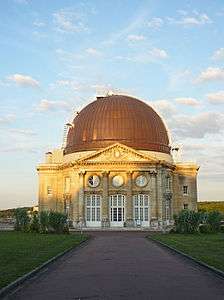
The largest practical functioning refracting telescope is the Swedish 1-m Solar Telescope, which is still used today for modern solar observations. Second is the Yerkes Observatory 40 inch (102 cm) refractor, used for astronomical and scientific observation for over a century, and the next biggest is the James Lick telescope, and the Meudon Great Refractor.[1]
Most are classical Great refractors, which used achromatic doublets on an equatorial mount. However, other large refractors include a 21st-century Solar telescope which is not directly comparable because it uses a single element non-achromatic lens, and the short-lived Great Paris Exhibition Telescope of 1900. It used a 78-inch (200 cm) Focault siderostat for aiming light into the Image-forming optical system part of the telescope, which had a 125 cm diameter lens. Using a siderostat incurs a reflective loss. Larger meniscus lenses have been used in later catadioptric telescopes which mix refractors and reflectors in the image-forming part of the telescope. As with reflecting telescopes, there was an ongoing struggle to balance cost with size, quality, and usefulness.
This highly inclusive list includes some additional more eccentric examples include the Great Paris telescope, which also used a mirror, and also some Solar telescope that also pose some additional nuances. The SST has an optical aperture of 98 cm (39.37"), although the lens itself is 110 cm (43,31") which can sometimes, depending on the precise wording can be listed as one of the larger lenses used in a telescope although make a list of telescopes based on the physical size of the lenses rather than the aperture poses additional research issues as such information is not always available. Also, its a single element lens whereas most of this list are doublets, with a crown and flint lens elements.
| Name/Observatory | Location at debut |
Modern location name or fate | Lens diameter | Focal length | Built | Comments | Image |
|---|---|---|---|---|---|---|---|
| Great Paris Exhibition Telescope of 1900[2] | Paris 1900 Exposition | Dismantled 1900 | 125 cm (49.21") | 57 m (187 feet) | 1900 | Fixed lens, scrapped. Aimed via a 2m reflecting siderostat | |
| Swedish 1-m Solar Telescope, ORM | La Palma, Spain | - | 110 cm (39.37") | 15 m | 2002 | Single element non-achromatic objective[3] combined with reflective Adaptive optics and a Schupmann corrector. The lens is 110 cm in diameter stopped down to 98 cm. | 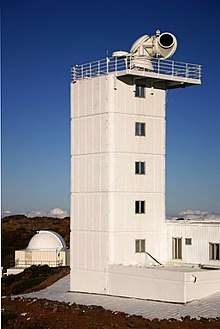 |
| Yerkes Observatory[4] | Williams Bay, Wisconsin, USA | - | 102 cm (40″) | 19.4 m (62′) | 1897 | Largest in current operation.[5] | 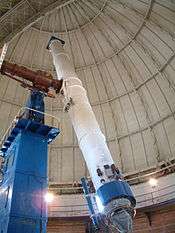 |
| James Lick telescope Lick Observatory | Mount Hamilton, California, USA | - | 91 cm (36″) | 17.6 m | 1888[2] | ||
| Grande Lunette Paris Observatory | Meudon, France | - | 83 cm + 62 cm (32.67"+24.41") | 16.2 m | 1891 | Double telescope | |
| Großer Refraktor Astrophysical Observatory Potsdam | Potsdam, Deutsches Kaiserreich | Potsdam, Germany | 80 cm + 50 cm (31.5"+19.5") | 12.0 m | 1899 | Double telescope by Repsold and Sons, optics by Steinheil | |
| Grande Lunette Nice Observatory | Nice, France | since 1988 Côte d'Azur Observatory | 77 cm (30.3″)[2][6] | 17.9 m | 1886 | Bischoffscheim funded | |
| William Thaw Telescope Allegheny Observatory, University of Pittsburgh | Pittsburgh, Pennsylvania, USA | - | 76 cm (30″) | 14.1 m | 1914 | Brashear made, photographic[7] | |
| Pulkovo observatory | Saint Petersburg, Russian Empire | Destroyed | 76 cm (30″) | 12.8 m (42 feet) | 1885 | Destroyed during WWII, only lens (made by Alvan Clark & Sons) survives. |  |
| 28-inch Grubb Refractor Royal Greenwich Observatory | Greenwich, London, Great Britain | - | 71 cm (28″) | 8.5 m | 1894 | ||
| Rolfscher Refraktor[8] | Rathenow, Germany | - | 70 cm (27.6″) | 20.8 m | 1949 | Single element non-achromatic objective with Schupmann corrector. | |
| Großer Refraktor Vienna Observatory | Vienna, Austrian Empire | Vienna, Austria | 69 cm (27" ) | 10.5 m | 1880 | Largest refractor in 1880, by Grubb[9] | |
| Great Treptow Refractor Treptow Observatory | Berlin, Germany | - | 68 cm (26.77") | 21 m | 1896 | renamed Archenhold Observatory 1946 | 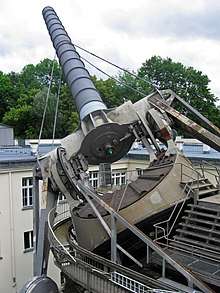 |
| Innes Telescope | Observatory Johannesburg, South Africa | Observatory Johannesburg, South Africa | 67 cm (26.5") | 11.6 m | 1909-1925 | Still in operation for educational purposes. By Grubb | |
| Yale-Columbia Refractor Yale Southern Station | Johannesburg, Union of South Africa | Relocated 1952 | 66 cm (26") | 10.8 m | 1925–1952 | Yale-Columbia Refractor moved to Mount Stromlo Observatory in 1952, same telescope as following entry. | |
| Yale-Columbia Refractor Mount Stromlo Observatory | Mount Stromlo, Australia | Destroyed 2003 | 66 cm (26") | 10.8 m | 1952 | Yale-Columbia Refractor - Previously located in South Africa. Relocated to Australia in 1952. Destroyed by bush fire on January 18, 2003.[10] |  |
| Leander McCormick Observatory | Charlottesville, Virginia, USA | - | 66 cm (26" ) | 9.9 m | 1884 | completed c. 1874, installed 1884 | |
| U.S. Naval Observatory | Foggy Bottom Washington, DC, USA | moved to Northwest, Washington, D.C., 1893 | 66 cm (26") | 9.9 m | 1873 | Largest refractor in 1873. Alvan Clark & Sons mounting replaced with Warner & Swasey mounting in 1893. |  |
| Thompson 26-inch Refractor[11] | Royal Observatory, Greenwich, Great Britain[11][12] | Equatorial Group, Herstmonceux, Sussex[11] | 66 cm (26")[11] | 6.82 m[11] | 1896 | Manufactured by Sir Howard Grubb as a gift from Sir Henry Thompson; originally used at Greenwich on the same mount as a 30-inch reflector[12] | .jpg) |
| Llano del Hato National Astronomical Observatory | Llano del Hato, Venezuela | - | 65 cm (25.6″) | 10.6 m | 1955 | ||
| Belgrade Observatory[13] | Belgrade, Kingdom of Serbia | Belgrade, Serbia | 65 cm (25.6″) | 10.55 m | 1932 | Zeiss made lens, same as at Berlin Observatory | |
| Hida Observatory | Gifu, Japan | - | 65 cm (25.6″) | 10.5 m | 1972 | ||
| 65 cm Zeiss Refractor, Pulkovo observatory | Germany[14] | Saint Petersburg, Russia | 65 cm (25.6″) | 10.413 m | 1954 | War reparation from Germany[14] In Pulkovo since 1954. | |
| Observatory History Museum Mitaka 65 cm | Mitaka, Tokyo, Japan | - | 65 cm (25.6″) | 10.21 m | 1929 | Carl Zeiss Jena | 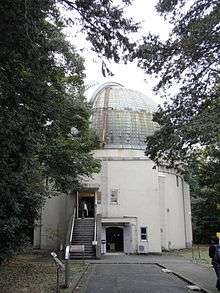 |
| Berlin-Babelsberg Observatory Berliner Sternwarte Babelsberg | Berlin, Germany | 65 cm (26 ") | 10.12 m (33 ft) | 1914 | Berlin Observatory just moved to Potsdam-Babelsberg in 1913; Zeiss lens | ||
| Newall Refractor[15] National Observatory of Athens | UK | Athens, Greece since 1957 | 62.5 cm (24.5″) | 8.86 m (29 ft) | 1869 | Built by Thomas Cooke for Robert Stirling Newall. First located at his estate; donated and relocated to Cambridge Observatory in 1889; donated to Athens Observatory and relocated to Mt. Penteli in Greece in 1957. Currently used only for educational purposes as part of the visitor center. | |
| Craig telescope | Wandsworth Common, London | Dismantled 1857 | 61 cm (24″) | 24.5 m (80 feet) | 1852 | Problem with lens figuring[16] | _(14740915186).jpg) |
| Sproul Observatory | Pennsylvania, USA | Dismantled July 2017 | 61 cm (24″) | 11.0 m (36 ft) | 1911 | Currently under restoration to be re-installed in Northwest Arkansas[17] | 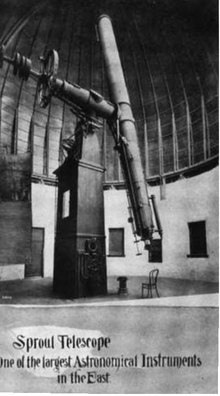 |
| Lowell Observatory | Arizona, USA | - | 61 cm (24″) | 9.75 m (32 ft) | 1894 | Alvan Clark & Sons telescope | 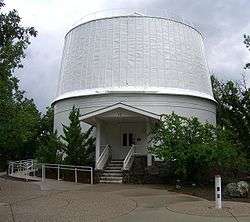 |
| Einstein Tower[18] | Potsdam, Germany | - | 60 cm (23.6″) | 14 m | 1924 | Tower telescope, fixed lens fed by a heliostat | |
| Zeiss Double Refractor Bosscha Observatory | Bandung, Dutch East Indies | Bandung, Indonesia | 60 cm (23.6″) | 10.7 m | 1928 | 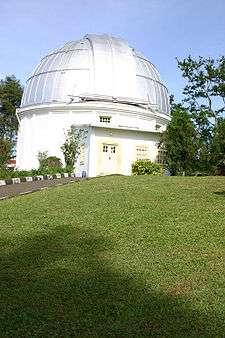 | |
| Großer Refraktor (Great Refractor)[19] Hamburg Observatory | Bergedorf, Germany | - | 60 cm (23.6″) | 9 m | 1911 | by Repsold and Sons, optics (visual + photographic lens) by Steinheil | 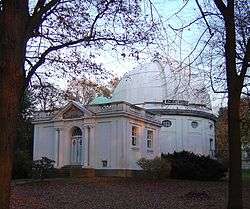 |
| Grubb Parsons Double Refractor | Saltsjöbaden, Sweden | - | 60 + 50 cm (23.6″+19.7") | 8.0 m | 1930 | Stockholm Observatory in Saltsjöbaden | |
| Radcliffe Double Refractor UCL Observatory | Oxford, UK | Mill Hill, London | 60 + 45 cm (23.6″ + 18") | 7.0 m | 1901 | Obtained from the Radcliffe Observatory and installed at UCLO (then known as "ULO") in 1938 | |
| Halstead Observatory | Princeton, USA | Roper Mountain Science Center,[20] Greenville, SC | 58.4 cm (23″) | 9.8 m (32 ft) | 1881 | by Alvan Clark & Sons | |
| Chamberlin Observatory | Colorado, USA | - | 50 cm (20″) | 8.5 m (28 ft) | 1891 | First Light 1894 | |
| Chabot Observatory | Oakland, California | Oakland, California, USA (2000) | 50 cm (20″) | 8.5 m (28 ft) | 1914 | "Rachel", Warner & Swazey Company (Optics John A Brashear Company) Refurbished in 2000 and moved to present location. | 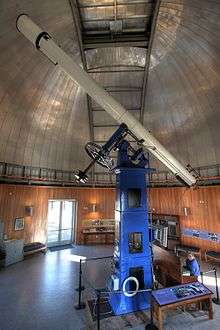 |
| Van Vleck Observatory | Connecticut, USA | - | 50 cm (20″) | 8.4 m (27.5 ft) | 1922 | ||
| Carnegie Double Astrograph Lick Observatory | Mount Hamilton, California, USA | Retired? | 50 cm (20″)x2 | 4.67 m (14 ft) | 1941/1962 (2nd lens) | F7.4 | 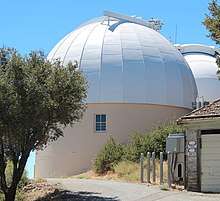 |
| Imperial Observatory | Straßburg, German Empire | Strasbourg, France | 48.5 cm (19.1″) | 7 m (23 ft) | 1880[21] | Then largest in German Empire | |
| 18½-in Dearborn Observatory Refractor | Chicago, USA | Evanston, USA | 47 cm (18.5″) | 1862 | by Alvan Clark & Sons | ||
| Luneta 46 Observatório Nacional | Rio de Janeiro, Brazil | - | 46 cm (18,4″) | 9,7 m | 1921 | T. Cooke & Sons[22][23] | |
| Wilder Observatory | Amherst College, Amherst, MA, USA | - | 46 cm (18″) | (25 ft) | 1903 | by Alvan Clark & Sons |  |
| Flower Observatory | Philadelphia, USA | - | 46 cm (18″) | 6.7 m (22.6 ft) | 1896 | ||
| Royal Observatory | Cape Colony, British Empire | South Africa | 46 cm (18″) | 6.7 m (22.6 ft) | 1897 | [24] | |
| Cooke-Zeiss Refractor, Royal Observatory of Belgium[25] | Uccle, Belgium | - | 45 cm (17.7″) | 6.99 m | 1891/1932 | by Cooke & Sons, original 38 cm lens by Merz replaced by 45 cm lens from Zeiss 1932 | |
| Gran Ecuatorial Gautier Telescope La Plata Astronomical Observatory | La Plata, Argentina | - | 43.3 cm (17″) | 9,7 m | 1894 | Gautier | |
| Brashear Refractor, Goodsell Observatory | Northfield, Minnesota, USA | - | 41.15 cm (16.2″) | 1890 | by John Brashear | ||
| Herget Telescope Cincinnati Observatory | Cincinnati, Ohio | - | 40.64 cm (16″) | 1904 | by Alvan Clark & Sons | ||
| Vatican Observatory | Castel Gandolfo, Italy | - | 40 cm (16″) | 6.0 m | 1881 | by Zeiss |  |
| Dorides Refractor[26] National Observatory of Athens | Athens, Greece | Athens, Greece | 40 cm (16″) | 5,08 m | 1901 | by Gautier[27] | |
| Washburn Observatory | Madison, Wisconsin, USA | In regular use for education and general public. | 39.5 cm (15.56″) | 6.7 m (22.6 ft) | 1881 | by Alvan Clark & Sons | |
| Dominion Observatory Refractor Dominion Observatory | Ottawa, Ontario, Canada | Moved to Helen Sawyer-Hogg Observatory (Canada Science and Technology Museum, Ottawa) in 1974[28] | 38.1 cm (15″) | 571.5 cm | 1905 | Original achromat doublet by John Brashear replaced with apochomat triplet by Perkin-Elmer in 1958. Currently used for education and outreach. | |
| Lunette Arago Paris Observatory | Paris, France | - | 38 cm (15") | 9 m | 1883 | by Gautier and Henry brothers |  |
| Double Refractor Fabra Observatory | Barcelona, Spain | - | 38 cm + 38 cm (15" + 15″) | 6 m + 4 m | 1904 | Double telescope by Mailhat, Paris | 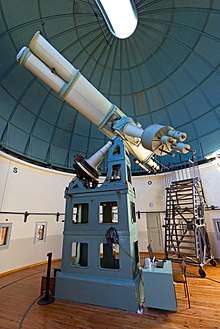 |
| Gran Ecuatorial Observatorio Astronómico Nacional | Tacubaya, México | - | 38 cm (15") | 4.8 m | 1885 | by Howard Grubb | |
| Harvard Great Refractor Harvard College Observatory[29] | Cambridge, Massachusetts, USA | - | 38 cm (15″) | 6.9 m | 1847 | largest telescope in America for 20 years[30] | 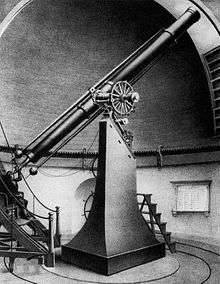 |
| Merz & Mahler Refractor, Pulkovo observatory | Saint Petersburg, Russian Empire | Rescued to Leningrad city in WWII (?) | 38 cm (15″) | 6.9 m | 1839 | (original) twin of the Harvard Great Refractor[29] | |
| Lunette coudée Lyon Observatory | Saint-Genis-Laval, France | - | 36.6 cm | 7.66 m | 1887 | Equatorial coudé by Maurice Loewy | |
| Telescopio Amici Osservatorio Astrofisico di Arcetri | Florence, Italy | - | 36 cm | 5 m | 1872 | 28 cm lens by G. B. Amici substituted by Zeiss lens in 1926. Currently used only for educational purposes. | |
| Photographic Refractor Leiden Observatory | Leiden, Netherlands | - | 34 cm + 15 cm (13.4″ + 5.9") | 524 cm | 1897 | Double telescope by Gautier and Henry brothers | |
| Astrograph Vienna Observatory | Vienna, Austrian Empire | Vienna, Austria | 34 cm + 26 cm (13.3″ + 10.2") | 3.4 m + 3.4 m | 1885 | Double telescope by Steinheil | |
| Perth Astrograph, Perth Observatory[31] | Old Perth Observatory, Mount Eliza, Western Australia | Perth Observatory, Bickley, Western Australia. Used for public education and outreach | 33 cm (13") | 3.34 m | 1897 | Designed and built by Howard Grubb & Co. Relocated to Bickley ~1966. The original telescope (both camera and guide scopes), mount and dome were re-erected at Bickley | |
| Fitz-Clark Refractor Allegheny Observatory, University of Pittsburgh | Pittsburgh, Pennsylvania, USA | - | 32.02 cm (13") | 4.62 | 1861 | Fitz made, visual/photographic. In 1895 established that Saturn's Rings are made up of particles and not solid.[7] | |
| H. Fitz-H.G. Fitz Refractor Henry Ruthurfurd, Private Observatory | New York City, USA | - | 32.02 cm (13") | 4.62 | 1864 | Fitz made, visual/photographic. Started by Henry, finished by son Henry Giles | |
| Bamberg Refractor Urania Observatory (Berlin) | Berlin-Moabit, Prussia | Berlin, Germany | 31.4 cm (12.36") | 5 m | 1889 | then biggest in Prussia, moved to Insulaner Wilhelm-Foerster Observatory in 1963[32] | |
| H. Fitz 12.6" refractor | Ann Arbor, Michigan, USA | 32 cm (12⅝") | 508 cm (200") | 1857 | The telescopes were restored to functionality as part of the University of Michigan's 2009 International Year of Astronomy celebration. Viewing nights and open houses[33] have been running since then. |  | |
| Grubb refractor, Keele Observatory[34] | Oxford, England | Keele University, England (since 1962),
in use for the public |
31.0 cm
(12.25") |
4.39 m | 1874 | Still awaiting the reunion with its 19th-century camera used in the Carte du Ciel project and to prove Einstein's general relativity theory during the 1919 solar eclipse. |  |
| Northumberland Telescope,[35] Institute of Astronomy, Cambridge University | Cambridge, England | Still in use by Cambridge University Astronomical Society and Cambridge Astronomical Association | 30 cm (12") | 5.95m | 1833 | Original lens 11.6" made by Cauchoix of Paris, replaced on 150th anniversary by 12" lens designed by R.V. Willstrop,[36] and made by A.E. Optics of Cambridge.[37] | |
| Urania Sternwarte (Zurich) | Zurich, Switzerland | - | 30 cm (12″) | 5.05 m | 1907 | by Zeiss | |
| Griffith Observatory | Los Angeles | - | 30 cm (12″) | 5.03 m | 1931 | by Zeiss | |
| Clark-Refraktor[38] Vienna Observatory | Vienna, Austrian Empire | Vienna, Austria | 30 cm (12″) | 5.06 m | 1880 | by Clark and Sons | |
| Deutsches Museum | Munich, Germany | - | 30 cm (12″) | 5.0 m | 1924 | by Zeiss | |
| Ladd Observatory, Brown University | Providence, Rhode Island, USA | Still in use for instruction and public education | 12-inch (30 cm) | 15 feet (4.6 m) | 1891 | Lens designed by Charles S. Hastings and made by John Brashear; telescope mount by George N. Saegmuller |  |
| Irving Porter Church Memorial Telescope Fuertes Observatory Cornell University | Ithaca, New York | Still used for instruction and public outreach. | 30 cm (12″) | 4.57 m (15 ft) | 1922 | Optics by John Brashear, mounting by Warner & Swasey. | |
| Jewett Observatory | Pullman, Washington, USA | Used for instruction and pleasure | 30 cm (12") | 4.57 m (15') | Assembled from older parts 1953[39] | Alvan Clark & Sons | |
| Silesian Planetarium and Astronomical Observatory | Katowice/Chorzów, Silesia, Poland | 30 cm (12")[40] | 4.5 m | 1955 | Largest and oldest Planetarium and Astronomical Observatory in Poland.[41] The 3rd largest in Eastern Europe (east of Germany), after Pulkovo Observatory in Saint Petersburg, Russia and Belgrade Observatory in Belgrade, Serbia | ||
| University of Illinois Observatory | Urbana, Illinois, USA | Used for instruction and pleasure | 30 cm (12″) | 4.57 m (15 ft) | 1896 | by John Brashear, National Historic Landmark, still used for instruction | |
| Mitchel Telescope Cincinnati Observatory | Cincinnati, Ohio, USA | - | 28 cm (11″) | 1843 | Merz & Mahler; Oldest professional telescope still used weekly by the public[42] |  | |
| Brashear Refractor Nicholas E. Wagman Observatory | Pittsburgh, Pennsylvania, USA | - | 28 cm (11″) | 1910 | John Brashear, Amateur Astronomers Association of Pittsburgh[43] | ||
| Great Refractor Kuffner Observatory | Vienna, Austria | - | 27 cm + 15.6 cm (10.6″ + 6.1") | 350 cm + 294 cm | 1884 + 1890 | Double telescope by Repsold and Sons, optics by Steinheil |  |
| Repsold Refractor (10-duims) Leiden Observatory | Leiden, Netherlands | - | 26.6 cm (10.5″) | 399,5 cm | 1885 | Repsold and Sons, optics by Alvan Clark & Sons | |
| Äquatoreal (Equatorial)[44] Hamburg Observatory | Millerntor Observatory, Hamburg, Germany | Hamburg Observatory, Bergedorf, Germany | 26 cm (10.2″) | 3 m | 1867 | Repsold and Sons, optics by G. & S. Merz | |
| Hume Cronyn Memorial Observatory | Western University London, Ontario, Canada | - | 25.4 cm (10″) | 4.386 m (172") | 1940 | by Perkin-Elmer Corp. Glass from Chance Brothers. | 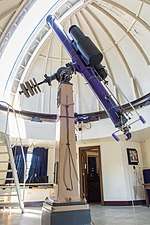 |
| Mills Observatory | Dundee, Scotland (1951) | 25 cm (10″) | 1871 | by T. Cooke & Sons. Training telescope at St. Andrews 1938-1951 | 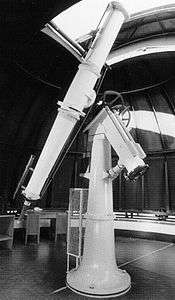 | ||
| Coats Observatory | Paisley, Scotland (1898) | 25 cm (10″) | 1898 | by Howard Grubb. Replaced 5" refractor by Thomas Cooke, installed in 1883. | |||
| Blackett Observatory | Marlborough College Wiltshire, England | - | 25 cm (10") | 1860 | by Thomas Cooke. | - | |
| Quito Astronomical Observatory | Quito | La Alameda park | 24 cm | 1875 | An operational 1875 Merz telescope and one of the Oldest Observatories in South America, founded in 1873. | ||
| Fraunhofer Refractor, United States Naval Observatory (Foggy Bottom) | Foggy Bottom, D.C., USA | 24.4 cm (9.6″) | 1844 [45] | ||||
| Fraunhofer-Refraktor Berlin Observatory | Berlin-Kreuzberg, Deutsches Kaiserreich | Moved 1913 to Munich, Germany | 24 cm (9.6″) | 4 m (13.4′) | 1835 | Used to discover Neptune; in Deutsches Museum, München since 1913[46] | |
| Great Dorpat Refractor (Fraunhofer) Dorpat/Tartu Observatory (Old Building) | Dorpat, Governorate of Livonia | Tartu, Estonia | 24 cm (9.6″) | 4 m (13.4′) | 1824 | "..the first modern, achromatic, refracting telescope."[47][48] |
Under construction
| Name/Observatory | Location at debut |
Modern location name or fate | Lens diameter | Focal length | Built | Comments | Image |
|---|---|---|---|---|---|---|---|
| Large Synoptic Survey Telescope | Cerro Pachón, Coquimbo Region, Chile | (Under development) | 157 cm (61.81") | 9.9175 m (32.5 feet) | 2019 | World's largest optical lens delivered for camera assembly in 2019; LSST begins imaging in 2023 | link |
See also
References
- Caplan, James; Le Guet Tully, Françoise (2008). "2008JHA....39..131C Page 131". Journal for the History of Astronomy. 39 (134): 131. Bibcode:2008JHA....39..131C. doi:10.1177/002182860803900114.
- Hollis, H. P. (1914). "Large Telescopes". The Observatory. 37: 245–252. Bibcode:1914Obs....37..245H.
- solarphysics.kva.se The Swedish 1 m Solar Telescope "By using a lens of a single glass, excellent image quality is obtained through very narrow filters that isolate a single wavelength or color." Archived 2008-06-16 at the Wayback Machine
- "The 40-inch". astro.uchicago.edu. Archived from the original on 2009-02-25. Retrieved 2009-02-27.
- "Yerkes Observatory | observatory, Williams Bay, Wisconsin, United States". Encyclopedia Britannica. Retrieved September 8, 2019.
- Hutchins, Roger (2008). British University Observatories, 1772–1939. Aldershot, England: Ashgate Publishers. ISBN 978-0-754-63250-4. Page 252.
- "Archived copy". Archived from the original on 2008-11-21. Retrieved 2009-03-30.CS1 maint: archived copy as title (link)
- "Startseite - Stadt Rathenow". www.rathenow.de.
- "Archived copy". Archived from the original on 2011-07-16. Retrieved 2009-08-14.CS1 maint: archived copy as title (link)
- Mount Stromlo Observatory brochure, page 12, The 26" Yale-Columbia Refractor, Australian National University, 2004, accessed 19 April 2008
- "Telescopes". The Observatory Science Centre. 2018. Retrieved 11 August 2018.
- "Royal Observatory, Greenwich". The Observatory. 20: 283–286. 1897. Bibcode:1897Obs....20..283.
- "ASTRONOMICAL OBSERVATORY BELGRADE". www.aob.bg.ac.rs.
- "1997JHA....28..177H Page 2:177". articles.adsabs.harvard.edu.
- "Institute for Astronomy, Astrophysics, Space Applications & Remote Sensing". www.astro.noa.gr. Retrieved September 8, 2019.
- "Welcome to the Online Museum of the Craig Telescope". www.craig-telescope.co.uk.
- Large telescope moves to Northwest Arkansas to further STEM recruitment goals
- Saar, Bettina. "Teleskop — Deutsch". www.aip.de.
- Hünsch, Matthias. "Großer Refraktor". www.hs.uni-hamburg.de.
- "Welcome to Roper Mountain Science Center!". www.ropermountain.org. Archived from the original on 2011-07-27. Retrieved 2010-11-13.
- "The Large Refractors Of The World". chestofbooks.com.
- Harper, W. E. (1929). "List of Refracting and Reflecting Telescopes". Journal of the Royal Astronomical Society of Canada. Royal Astronomical Society of Canada. 23: 351–355. Bibcode:1929JRASC..23..351H. See page 352.
- Taylor, E. Wilfred; Wilson, J. Simms; Maxwell, P. D. Scott. At the Sign of the Orrery: The Origins of the Firm of Cooke, Troughton and Simms, Ltd. (Not dated, no publisher given.) See page 49.
- Scientific American Reference Book. A Manual for the Office, Household and Shop Author Albert A. Hopkins, A. Russell Bond Publisher Munn & Company Year 1905 Copyright 1904, Munn & Company
- "Bruxelles 45 - AstroEquatoriales". astroequatoriales.free.fr.
- "Dorides Refracting Telescope - The Hellenic Archives of Scientific Instruments". www.hasi.gr.
- "Gautier, Paul Ferdinand - The Hellenic Archives of Scientific Instruments". www.hasi.gr.
- "CSTM Homepage - Canada Science and Technology Museum". www.sciencetech.technomuses.ca.
- Group, CfA Web Services. "Harvard College Observatory: Great Refractor". www.cfa.harvard.edu.
- "Telescope: Harvard 15-inch Refractor". amazing-space.stsci.edu.
- "Perth Observatory - Star Viewing Nights and Tours". Retrieved September 8, 2019.
- "Archived copy". Archived from the original on 2004-11-27. Retrieved 2009-03-28.CS1 maint: archived copy as title (link)
- "Detroit Observatory Open Houses | U-M LSA Astronomy". lsa.umich.edu. Retrieved September 8, 2019.
- University, Keele. "Keele Observatory, Keele University". Keele University. Retrieved September 8, 2019.
- "Northumberland Telescope | Institute of Astronomy". www.ast.cam.ac.uk. Retrieved September 8, 2019.
- "Dr Roderick V Willstrop | Institute of Astronomy". www.ast.cam.ac.uk. Retrieved September 8, 2019.
- "Northumberland Telescope | Institute of Astronomy". www.ast.cam.ac.uk. Retrieved 2019-03-07.
- "Objekt des Monats : Refraktor von Clark & Sons". bibliothek.univie.ac.at.
- "Astronomy Program - Jewett Observatory". astro.wsu.edu.
- "Planetarium i Obserwatorium im. Mikołaja Kopernika w Chorzowie". www.planetarium.edu.pl.
- "Archived copy". Archived from the original on 2011-07-18. Retrieved 2010-07-22.CS1 maint: archived copy as title (link)
- "Archived copy". Archived from the original on 2010-12-13. Retrieved 2010-12-22.CS1 maint: archived copy as title (link)
- "Amateur Astronomers Association of Pittsburgh". Retrieved September 8, 2019.
- Hünsch, Matthias. "Äquatoreal". www.hs.uni-hamburg.de.
- The General History of Astronomy. 1900. ISBN 9780521242561.
- Daugherty, Brian. "Berlin - History of Astronomy in Berlin". bdaugherty.tripod.com. Archived from the original on 2011-08-11. Retrieved 2009-03-28.
- Waaland, J. Robert (1967). "Fraunhofer and the Great Dorpat Refractor". American Journal of Physics. 35 (4): 344. Bibcode:1967AmJPh..35..344W. doi:10.1119/1.1974076.CS1 maint: uses authors parameter (link)
- "Fraunhoferi refraktor". www.obs.ee.
Further reading
- Ian Ridpath (2001). The Illustrated Encyclopedia of the Universe. Watson-Guptill Publications. ISBN 978-0-8230-2512-1.
- List of largest refracting telescopes circa 1914 List